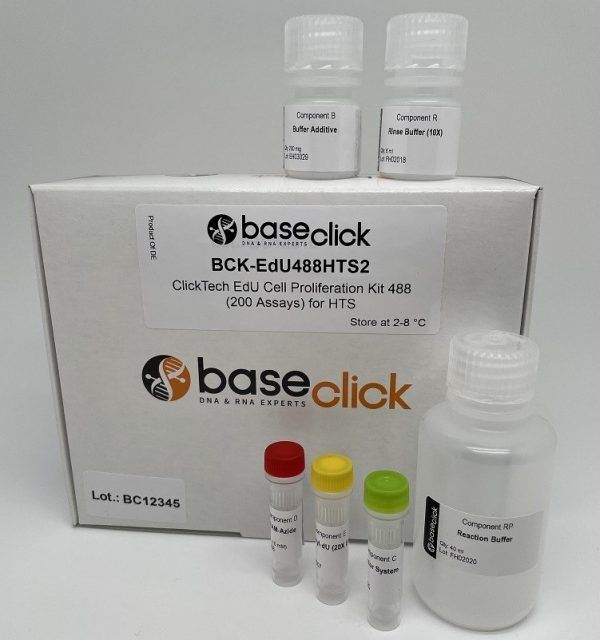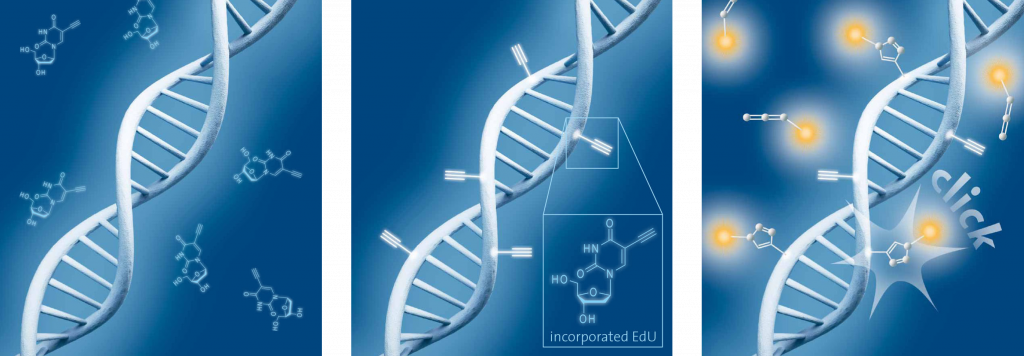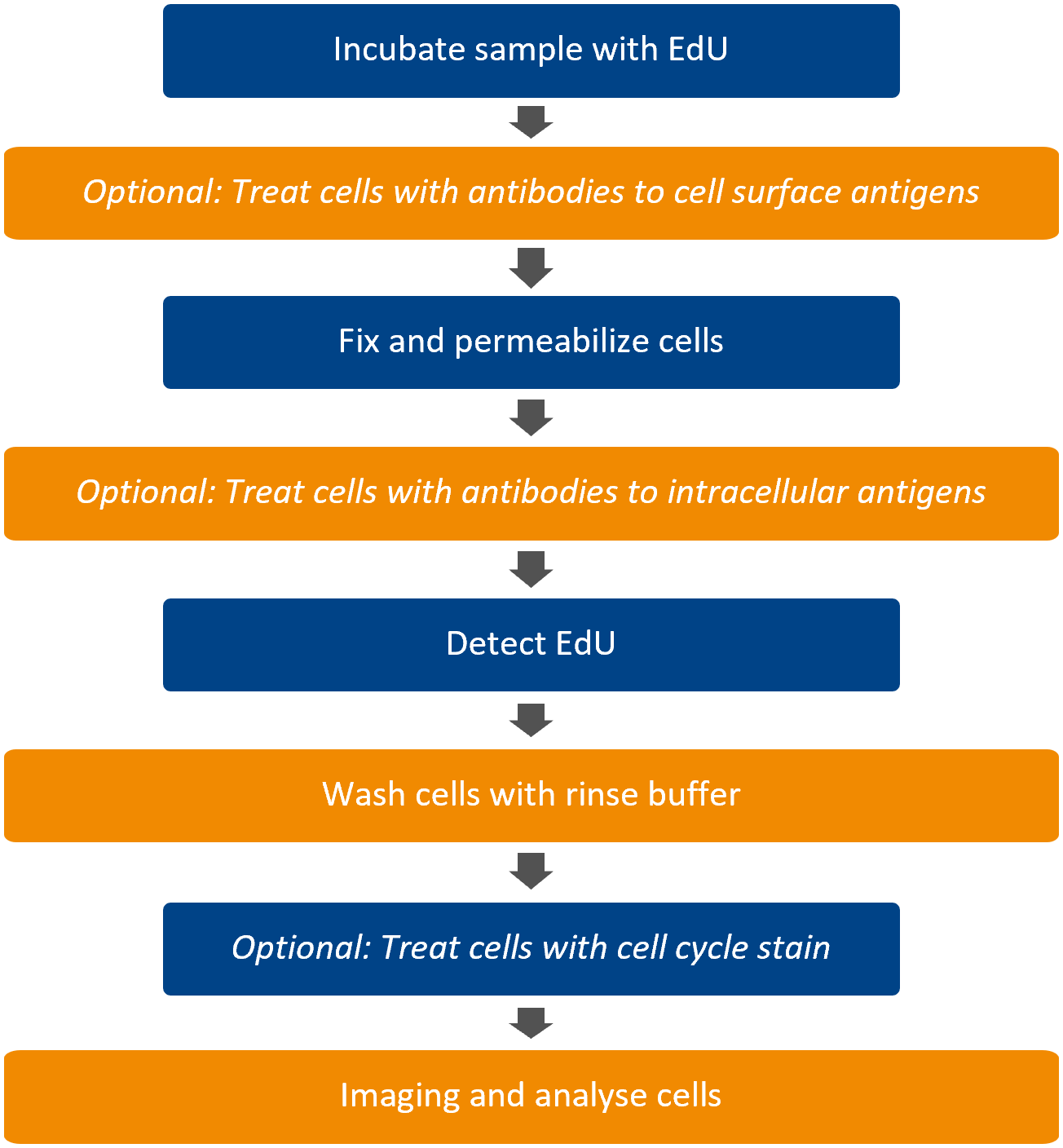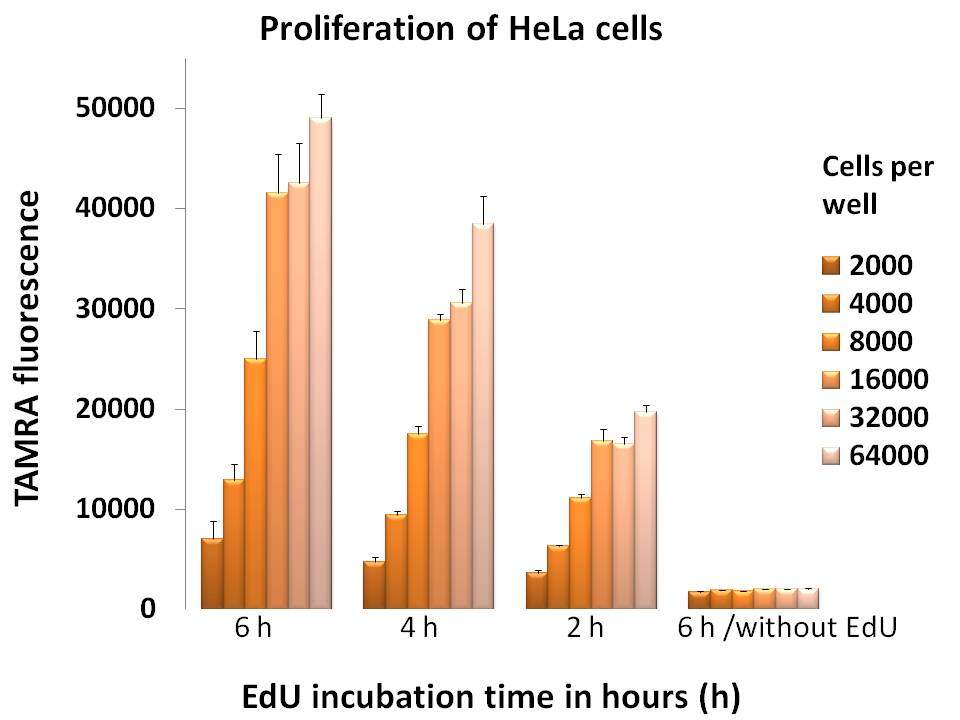EdU Cell Proliferation Assay for High-throughput Screening
ClickTech EdU Cell Proliferation Kit for HTS

| Size | Catalog No. | Price |
|---|---|---|
| Dye 488 / 2x 96 well plates | BCK-EdU488HTS2 | € 380,00 |
| Dye 488 / 4x 96 well plates | BCK-EdU488HTS4 | € 590,00 |
| Dye 555 / 2x 96 well plates | BCK-EdU555HTS2 | € 380,00 |
| Dye 555 / 4x 96 well plates | BCK-EdU555HTS4 | € 590,00 |
-
Cell Analysis – Cell Proliferation High-throughput Screening Assays
Cell analysis allows scientists to gain unique insights into cell proliferation, viability, and toxicity, enabling the monitoring of cell response and cell health in cultures after treatment with various stimuli.
Detection of DNA replication is a powerful tool for studying proliferation of both cell populations and individual cells. DNA replication rates can be detected through the incorporation of a nucleoside analog such as BrdU or EdU into DNA. The detection of these two thymidine analogs differs significantly and has implications for test results, potential applications, and multiplexing capability. Compared to other cell proliferation methods, the EdU proliferation assay does not involve radioactive isotopes or antibodies to detect newly synthesized DNA.
The ClickTech EdU cell proliferation assay enables estimates of cell proliferation rates by determining the fraction of cells replicating their DNA.
The technology is based on the labeling of DNA with EdU (5-ethynyl-2′-deoxyuridine), an alkyne-modified nucleoside that is incorporated into the replicating DNA of living cells and its conjugation to a fluorochrome in situ.

Schematic representation of EdU cell proliferation assays. A) Incubation of cells with EdU. B) EdU is incorporated during active DNA synthesis. C) Detection of cell proliferation via click chemistry, wherein the use of a range of different fluorescent dyes is possible.
Advantages:
- Increased selectivity and sensibility in comparison to BrdU
- Simple, fast and reliable assay
- High sensitivity paired with very low toxicity
- A cost-effective assay
- Multiplexing possibility
- higher preservation of morphological details relative to BrdU

ClickTech EdU Cell Proliferation Assays for HTS
The baseclick ClickTech EdU cell Proliferation assays overcome the limitations of conventional cell proliferation assays and offer a superior alternative to BrdU and [3H] thymidine assays. EdU (5-ethynyl-2′-deoxyuridine) is an alkyne-modified thymidine analog, which is incorporated into DNA during active DNA synthesis.Functional alkyne and azide groups do not occur in natural cell systems and do not react without catalytic reagents. This ensures that the EdU cell proliferation method, based on click chemistry, is highly selective, sensitive and reproducible. This technology allows an almost unlimited choice of different and easy to synthesize fluorescent dyes and thus offers maximum flexibility in terms of “detection colors” and analytical devices. Cell proliferation can be detected by fluorescence microscopy, flow cytometry and fluorescence plate reader. baseclick currently offers assays for these three analytical methods and up to four standard dyes (488, 555, 594, 647 nm). The optimized detection protocol considerably simplifies the workflow and the time required. The simple detection procedure is completed within 30 minutes and is compatible with multiplexing for content- and context-rich results.
Workflow

Application
High Throughput Screening (HTS) is widely used in the pharmaceutical industry for drug discovery purposes. It is used to simultaneously study the effects of large numbers of compounds such as ligands (for receptors, ion channels or other pharmacological targets) on cell proliferation/DNA synthesis or toxicity. The baseclick EdU HTS kits measure DNA synthesis of adherent cells in 96 well plates and enable multiplexing with a variety of fluorescent dyes.

EdU incorporation over time and increasing cell numbers. HeLa cells were seeded at the indicated densities in a 96 well plate and were incubated with 10 µM EdU for 2, 4 and 6 hrs. EdU incorporation was detected using the BCK-EdU555HTS Kit.
Product Overview

LITERATURE
Establishment of long-term ostracod epidermal culture, S. Morgan et al., 2020, In Vitro Cell. Dev. Biol. Anim., Vol. 56, p. 760-772.
https://doi.org/10.1007/s11626-020-00508-8
Exposure of vital cells to necrotic cell lysates induce the IRE1α branch of the unfolded protein response and cell proliferation, P. Rohne et al., 2017, Cell Stress and Chaperones, Vol. 23, p. 77-89.
https://doi.org/10.1007/s12192-017-0825-6
Satellite DNA in Vicia faba is characterized by remarkable diversity in its sequence composition, association with centromeres, and replication timing, L. Robledillo et al., 2018, Scientific Reports, Vol. 8, p. 5838.
https://doi.org/10.1038/s41598-018-24196-3
LINC00319 acts as a microRNA-335–5p sponge to accelerate tumor growth and metastasis in gastric cancer by upregulating ADCY3, J. Zou et al., 2019, American Journal of Physiology-Gastrointestinal and Liver Physiology, Vol. 318(1), G10-G22.
FAQ
-
What type of cells can incorporate EdU?
The EdU cell proliferation assay has been applied to many different cell types and organisms from prokaryotic to eukaryotic. Cell lines such as E. coli, HeLa, HEK, MOLM are arguably among the most routine applications, but also animals, like mouse, rat, the nematode C. elegans, crickets (Gryllus bimaculatus), chicken (Gallus domesticus) and zebra fish (Danio rerio) or even plants (e.g. Arabidopsis thaliana) can be applied.
Cells that possess a pyrimidine pathway that can phosphorylate EdU to the corresponding triphosphate, which is then accepted by the host DNA polymerase for incorporation into DNA during replication. -
Can I perform EdU cell proliferation detection on living cells?
EdU is incorporated into living cells, but the detection reaction must be performed on fixed and permeabilized samples.
-
How does EdU labeling compare to BrdU or the 3H-thymidine incorporation assay?
All three methods enable to determine cell proliferation directly by incorporation of a metabolite analogue and subsequent detection. The 3H-thymidine incorporation assay is very sensitive, but the radioactive compound requires specialized equipment and dedicated lab space for handling. EdU and BrdU assays are non-radioactive alternatives with decreased risk for health and environment. Compared to the BrdU incorporation assay the EdU assay is more sensitive, requires less handling time and needs no harsh DNA denaturing conditions for detection. Therefore, the EdU cell proliferation is also compatible with multiplexing.
-
Can I combine DAPI staining and EdU detection?
Yes, this is feasible. Please note that DAPI staining should be done after the click detection step. Alternatively, SYBR Green DNA staining can be used. But, please note that SYBR green should not be used with dyes of 488 nm wavelengths.
-
When can I safely interrupt the experiment?
It is possible to safely interrupt the protocol after the fixation step. Thereto, remove the fixation solution and wash as suggested by the user manual, then the cells can be stored in buffer at 4° C. Alternatively, the experiment can also be safely interrupted after permeabilization, again as described above.
Please note: It is important to proceed with the experiment if the click cocktail for the detection of the EdU has been prepared already. -
Is antibody staining compatible with the EdU?
Antibody staining is compatible with EdU cell proliferation detection when antibody detection is done after the click detection step. Please be aware of the dye used for EdU detection. Check also the user manual for more information.
-
How to determine the EdU incubation time?
The EdU incubation time depends on the cell type or organism, the applied EdU concentration and the experimental design. For a start it is advisable to refer to a literature protocol (which is close to your experimental setup) and to test the conditions with a low number of samples. As a general guideline we recommend to use a maximum of 10 µM final EdU in the cell culture medium for incubations. For longer incubation (> 1 day) the concentration should be decreased to 1-5 µM.
-
-
Shelf Life
12 months unopened after receipt
-
Storage Conditions
2-8 °C
-
Physical State
kit system made of different components
-
CAS Number
n.a.
-
Excitation (max)
Dye 488: 496 nm | Dye 555: 546 nm
-
Emission (max)
Dye 488: 516 nm | Dye 555: 579 nm
-
Ɛ (max)
Dye 488: 83.000 cm-1M-1 | Dye 555: 91.000 cm-1M-1
-
Preparation/Handling
please see user manual of the kit
-
Shelf Life

